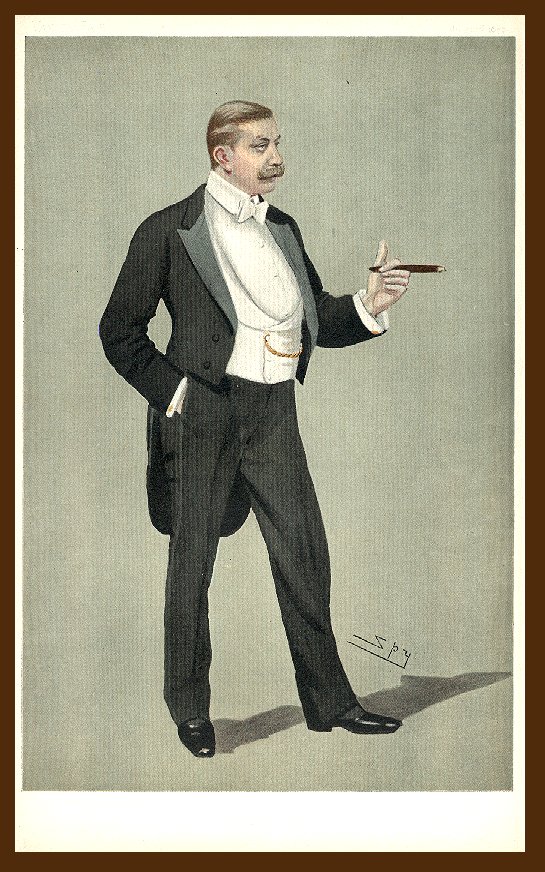| ECKARDSTEIN,
BARON VON
Neg.
No: 3504A
Neg. Size: 15"x12"
Neg. Date: 16-9-1902


Sitter:
Baron Hermann von Eckardstein (1864-1933).

Biog:
German diplomat.
ECKARDSTEIN,
Hermann Von, Baron [1864-1933]. He entered the diplomatic corps in
1888, serving in London 1891-1901. Though never ambassador, as first
secretary he performed most of the functions of one. He resigned from
the diplomatic service in 1907. At the beginning of World War 1 he
was on the staff of the Crown Prince but was soon removed. As a diplomat
and a soldier he was more eager to increase his own prestige and fortune
than those of his country. His writings included Personal Memories
of King Edward, 1927, and Die Entlassung des Fürsten
Bulow, 1931. He married the daughter and heiress of Sir John
Blundell Maple, but they later divorced.
[no source ???]
Baron Von Eckardstein,
Ten Years at the Court of St. James’ 1895-1905, Thronton
Butterworth Limited, London, 1921
[Preface: Prof.
George Young] [p 7] Those who remember the official functions of late
Victorian and Edwardian London will have a memory picture of Baron
von Eckardstein in his white Cuirassier uniform towering above the
tall men and women of London society. From his glittering helmet to
his gleaming jackboots he seemed an embodiment of the military Empire
he represented.
Date:
16 September 1902.
Occasion:
-
Location:
The Lafayette Studio, 179 New Bond Street, London.
Descr:
FL standing.
Costume:
Dress Uniform, Brandenburg Cuirasser.
The man in the
photo is wearing the dress uniform of the Brandenburg Cuirassers,
a heavy cavalry unit. Cuirassiers wore the steel upper body armor,
and a metal helmet called a lobster tail by collectors. It had a very
long neck extension of overlapping plates that looked somewhat like
the overlapping plates on a lobster.
In the Kaiser's time, if you were in any way associated with the government,
civil service, police, customs, diplomats, firemen, army, etc., you
had a uniform with some type of headress or helmet. This is confusing
to some people, as they generally associate helmets with the military.
Diplomats wore a unique spiked helmet made of leather with a fluted
spike. The man in the photo is wearing the military uniform of the
cavalry, with a metal helmet, but without the metal breast and back
armor of the cuirassier, which were a holdover of the 16th Century
style of armored cavalry.
By the end of the 18th century, developments in flintlock muskets
made body armor obsolete, but some cerimonial and traditional types
were kept by the cavalry.
The helmets of 1914 were not meant to stop bullets, shell fragments,
or shrapnel balls, they were purely decorative and traditional in
nature. By the end of 1916 all armies had developed the ballistic
type of helmet that was meant to provide protection from all the flying
metal fragments, bullets, and shrapnell balls of the modern battlefield.
It was a type of reverse evolution as the nature of trench warfare
called back into several obsolete military hardware items back into
service including the hand grenade and the short range high trajectory
mortar.
The sword, spear, armored helmet, and body armor, grenade and short
range mortar ( all associated with close engagement with the enemy)
all had been discarded in the 19th century do the long range abilities
of the rifle. Weapons discarded in the middle ages also made a short
comeback in the trenches, such as the club, the mace, the dagger,
the truncheon, etc, which were handy in the close confines of fighting
in a trench.
[Information
kindly provided by Ralph Reiley]
Orders,
Decorations & Medals: Badge and star of the (Austrian) Order
of St John and of Malta; badge of an (honorary) Knight Commander of The
Royal Victorian Order (K.C.V.O.); star of the (Mecklenburg) Order of the
Griffin; badge of the Royal House Order of Hohenzollern; badge of the
(Prussian) Order of the Red Eagle; badge of the (Prussian) Order of the
Crown ; the Kaiser Wilhelm Centenary Medal (1897).
Furniture
& Props: -

Photographer:
Lafayette Ltd., 179 New Bond Street, London. Evidence
of photographer at work: -
No
of poses: 2.
 
Copyright:
V&A
All
images on this site are copyright V&A. For further information on
using or requesting copies of any images please contact the V&A Picture
Library: vaimages@vam.ac.uk
including the URL of the relevant page
Provenance:
Pinewood Studios; acquired 1989.

References:
Biog:
Baron von Eckardstein, Ten Years at the Court of St. James' 1895-1905,
London, 1921; The Times, 7 November 1902, (Court Circular).
Occasion:
-
Costume:
Baron von Eckhardstein, ibid p. 7.
Orders,
Decorations & Medals: (Royal Victorian Order)
Burke's Peerage; (Kaiser Wilhelm Centenary Medal)
H.T. Dorling, Ribbons and Medals, London, 1983; (others)
R. Werlich, Orders and Decorations of All Nations, Washington,
1990; See also Baron von Eckhardstein, ibid. pp. 125 & 245.
Reproduced:
-
NB; Vanity
Fair, 1898 "A German Attaché"


Acknowledgements:

|